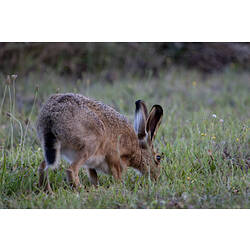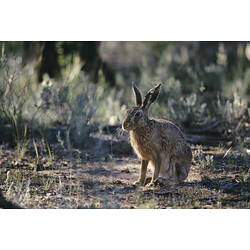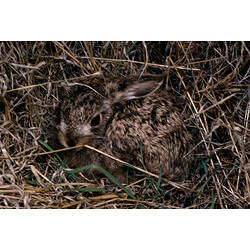General Description
Hares look superficially similar to rabbits, but are larger and their hind legs and ears are longer relative to their bodies. Body fur mottled black and brown with brown-grey on the cheeks, shoulders, sides and rump. Long black-tipped ears that extend beyond the nose if held forward. Tail white with a black stripe (visible when hopping). Sits upright. Body up to 65 cm long.
Biology
Hares eat grass, fleshy plant roots (tubers) and bark from shrubs and small trees. They are considered a minor agricultural pest. They are usually solitary except when breeding. When threatened, they freeze, often pressing themselves to the ground. When the threat gets close, they will break cover and run away rapidly, often bounding sideways and doubling back to confuse the predator. Unlike rabbits, hares do not live in underground warrens, but rest in shallow depressions in the ground known as "forms". There is some debate about whether the Brown Hare (Lepus capensis) and the European Hare (Lepus europaeus) are the same species. If so, the name Lepus capensis would take priority as it was published first. Hares were deliberately introduced to Australia multiple times from the 1830s for sport.
Distribution
Europe, South American, New Zealand. South-eastern and eastern mainland Australia and Tasmania.
Habitat
Farmland and grasslands.
More Information
-
Animal Type
-
Animal SubType
-
Brief Id
Sits upright, ears longer than the length of the head.
-
Colours
Brown, Black, Grey
-
Habitats
-
Where To Look
-
When Active
Nocturnal
-
Diet
Herbivore
-
Diet Categories
Grasses, Vegetable crops
-
Endemicity
-
Conservation Statuses
CITES: Not listed, FFG Threatened List: Not listed, EPBC Act 1999: Not listed, IUCN Red List: Least concern
-
Taxon Name
-
Common Name
European Hare
-
Kingdom
-
Phylum
-
Subphylum
-
Class
-
Order
-
Family
-
Genus
-
Species Name
europaeus






